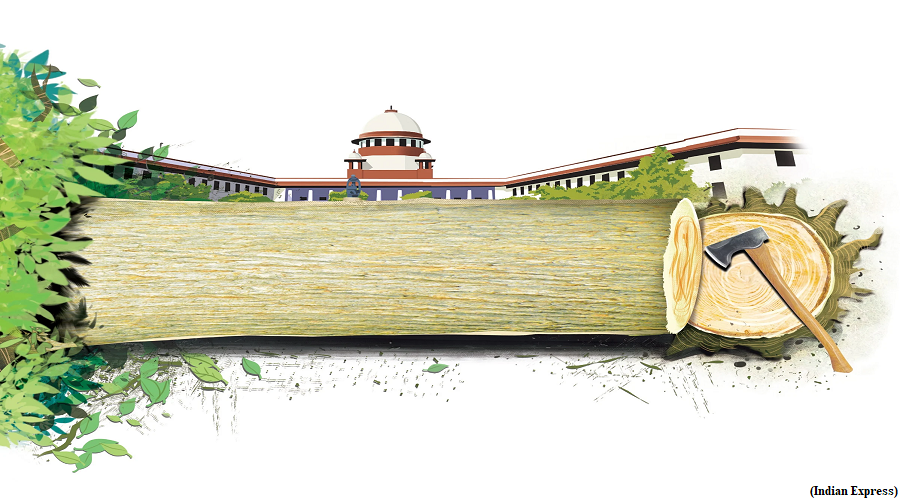What is the SC interim order on the Forest Act? (GS Paper 3, Environment)

Why in news?
- Recently, the Supreme Court ordered the government to continue following the all-encompassing “dictionary meaning” of forest as upheld in a 1996 Supreme Court decision in the T.N. Godavarman Thirumulpad case till a final verdict is handed out on a petition challenging the amended Forest Conservation Act of 2023.
- The court has also asked the government to make public, by April, a consolidated record of land deemed as forest by States and Union Territories.
What is the Forest Conservation Act?
- The Forest Conservation Act, which came into force in 1980, was conceived to stop the razing of forests.
- An estimated four million hectares of forest land had been diverted from 1951-75 and once the Act came into force, the average annual rate of diversion dropped to about 22,000 hectares or about a tenth going by figures cited by the Centre to a parliamentary panel to demonstrate the effectiveness of the legislation.
- However, the provisions of this legislation predominantly applied to tracts of forest land recognised as such by the Indian Forest Act, or by States in their records since 1980.
1996 Judgement:
- Illegal timber-felling at Gudalur in Tamil Nadu led the Supreme Court to deliver the landmark Godavarman Thirumulpad judgment in 1996.
- It decreed that forests had to be protected irrespective of how they were classified and who owned them.
- This brought in the concept of ‘deemed forests,’ or forest-like tracts that weren’t officially classified as such in government or revenue records but looked like them.
Statewise interpretation:
- In the 28 years that have passed since the judgment, States have interpreted ‘forests’ differently. This is natural, given the wide variety of forests and constituent plants in India.
- Chhattisgarh and Madhya Pradesh, for instance, define a forest as a tract that spans a minimum of 10 hectares, is covered with naturally growing timber, fuel wood and yielding trees and, has a density of 200 trees or more per hectare.
- Goa defines a forest as a patch of land having at least 75% covered with forest species.
- Some States have no parameters at all. Because of varying definitions of deemed forest, estimates of their territorial spread in India range from 1% - 28% of India’s official forest area of 80 million ha.
Recent judgement:
- The Centre’s recent attempt to amend the Forest Conservation Act was ostensibly to bring “clarity” as there were large tracts of recorded-forest land that had already been legally put to non-forestry uses, but conformed to a State’s criteria of a ‘deemed forest.’
- This posed challenges to the use and ownership of such land. Such ambiguity also bred a reluctance among private citizens to cultivate private plantations and orchards, despite their significant ecological benefits, for fear that they would be classified as ‘forest’ (and thus render their ownership void).
- India’s ambitions to create a carbon sink of 2.5-3 billion tonnes, to meet its net-zero goals required forest laws to be “dynamic”, and the rules sought to remove ‘deemed forest,’ not already recorded as such, from the ambit of protection.
What did the amendments deal with?
- The amendments also put beyond the pale of protection forest land situated alongside a rail line or a road, necessary to provide access to a habitation, up to a maximum size of 0.10 hectare.
- Forest land situated within a distance of 100 kilometres along international borders or the Line of Control or Line of Actual Control, and which needed to be cleared to construct strategic linear projects of national importance would also be exempt from the Act.
- Any ten hectares in a forest, regarded necessary for use in constructing security related infrastructure or five hectares in forest land affected by ‘left wing extremism’ too would be bereft of protection.
- The government rationale is that these exemptions are necessary to facilitate basic infrastructure in tribal areas. Moreover, the proper protection and conservation of forests by local communities, the Centre argued, requires creating livelihood opportunities through the promotion of ecotourism, zoos and safaris.
- But critics have pointed out that such enabling provisions already exist in another Act, the Forest Rights Act, 2006.
What is the import of the SC order?
- The Supreme Court’s interim order implies that forests will continue to be governed as if the recent amendments of the Centre didn’t exist.
- It said that States should provide and the Centre publish, reports by State-constituted expert committees on the extent of deemed forests within their territories. It also struck down schemes to constitute zoos and safari parks on forest land.


